#Cheng Sze Sze
Explore tagged Tumblr posts
Text
#Bao Choy#RTHK#journalism#HK Court of Final Appeal#721 yuen long attack#freedom of the press#Choy Yuk Ling#The Collective#Nieman Fellowship#police#documentary#investigative journalism#Hong Kong Connection#media#news#professionalism#Apple Daily#Stand News#Citizen News#Cheng Sze Sze#public broadcasting#hong kong national security law#hong kong#hong kong free press#Lui Tsz Lok#Fanny Kwan#antiELAB#反送中
0 notes
Text
“Furthermore, because he can only express himself of those terms [of opera], [Cheng] Dieyi now appears, within our contemporary discourse of gay identity, suspiciously anachronistic and ‘incorrect.’ From where he stands, Dieyi has no place in the past, present, or future. While it has been remarked that the xianggong ‘did not make it into the 20th Century,’ it seems to me that someone like Dieyi never made it into history at all.”
— absolutely devastating quote from Helen Hok-Sze Leung’s Farewell My Concubine: A Queer Film Classic that I have not stopped thinking about for weeks
#it’s an ebook from the library so i don’t have page numbers but it’s in chapter three#farewell my concubine#sil speaks
11 notes
·
View notes
Text
百家姓在全球各个华语地区的拼音
中文 中國大陸 台灣 香港 澳門 新加坡 馬來西亞 越南 韩国
1 赵 Zhao Chao Chiu Chio Chow Teoh/ Chew/ Tiew Trieu Jo/Cho
2 钱 Qian Chien Chin Chin Zee Chien/Chen Tien Joen/Chun
3 孙 Sun Sun Suen Sun Soon Soon/Sun/Shun/Song Ton Son
4 李 Li Li / Lee Li / Lee Lei Lee Lee/Li Ly Lee / Rhee/ Yi
5 周 Zhou Chou Chow / Chau Chao Chew Chew / Cheu / Chou / Chow / Chiew Chu Ju/Chu
6 吴 Wu Wu Ng Ng Goh Ng / Goh / Ngo/ Ngu Ngo Oh
7 郑 Zheng Cheng Cheng Cheang Tay Ching / Tang / Tey / Tay / Tee / Teh / Cheng / Chin / Chang / Chung / Chiang Trinh
8 王 Wang Wang Wong Vong / Wong Ong / Wong Ong / Ng / Wong / Wang / Bong / Heng Vuong Wang
9 冯 Feng Feng Fung Fong Foong/Fung/Fong Phung Pung
10 陈 Chen Chen Chan Chan Tan / Chan / Ting Chan / Chin / Chen / Tan / Tang / Ting / Sin Tran Jin/Chin
11 褚 Chu Chu Chu Chu Too/Toh
12 卫 Wei Wei Wai Wai Wee/Wei Vi Ui/Oui
13 蒋 Jiang Chiang Cheung Cheong Chiang/Cheong/Chiong Tuong Jang/Chang
14 沈 Shen Shen Shum / Sum Sam Sim Sim/Shim/Shun/Shum Sim
15 韩 Han Han Hon Hon Hon/Hong Han Han
16 杨 Yang Yang Yeung Ieong Yeo / Yong Yong / Yeo / Yeoh / Eow / Yeong / Yew Duong Yang
17 朱 Zhu Chu Chu Chu Choo Chu/Choo/Jee/Jeh Chau Chu/ Joo
18 秦 Qin Chin Chun Chin/Ch'ng Tan Jin/Chin
19 尤 You Yu Yau Iao Yew/You Vuu
20 许 Xu Hsu Hui Hoi Hee / Koh Khu / Khoo / Khor / Khow / Hoo / Hooi / Khaw / Hii Hu Heo/Huh
21 何 He Ho Ho Ho Hoh Ho/Hoh/Hor Ha Ha
22 吕 Lu Lu Lui Loi Loh/Lei/Lui/Lee La/Lu Yeo/Ryeo
23 施 Shi Shih Sze Si See/Sii/Sih
24 张 Zhang Chang Cheung Cheong Cheong Cheong / Chong / Teo / Chang / Teoh / Tiong Truong Jang/Chang
25 孔 Kong Kung Hung Hong Kong/Khong/Kung Khong Gong/Kong
26 曹 Cao Tsao Cho / Tso Chou Cheng/Choo/Cho/Chu/Chao Tao Cho/Jo
27 严 Yan Yen Yim Im Yam/Ngim Nghiem Im
28 华 Hua Hua Wa / Wah Wa Hoa Wha/Wah/Wa
29 金 Jin Chin Kam Kam Kim/King Kim Kim
30 魏 Wei Wei Ngai Ngai Ngui/Gui/Woi Nguy Ui/Oui
31 陶 Tao Tao To Tou Tho/To/Too/Toh Dao Do/To
32 姜 Jiang Chiang Keung Keong Khiang/Kiang Giang Kang/Gang
33 戚 Qi Chi Chik Chek Cheok
34 谢 Xie Hsieh Tse Che Cheah / Tay / Chia Cheah / Chiah / Chia / Seah / Sia / See Ta Sa
35 邹 Zou Tsou Chau / Chow Chao Chew/Chou/Chu
36 喻 Yu Yu Yu U Yu/Yho/Yuh You/Yu
37 柏 Bai Pai Pak Pak
38 水 Shui Shui Sui Soi Shu/Tshui
39 窦 Dou Tou Tau Tao
40 章 Zhang Chang Cheung Cheong Cheong/Chong/Teo/Tiong/Tong
[编辑] 百家姓41-80
中文 中國大陸 台灣 香港 澳門 新加坡 馬來西亞 越南 韩国
41 云 Yun Yun Wan Wan Woon/Wun/Yun/Yung
42 苏 Su Su So Sou Soh Soh / Saw / Soo To
43 潘 Pan Pan Poon / Pun Pun Phua Phua / Pan / Pang / Phang Phan Ban
44 葛 Ge Ko Kot Gal
45 奚 Xi Hsi Hai Kai Hae
46 范 Fan Fan Fan Fan Fung / Fam / Fang / Hwang Pham Bum
47 彭 Peng Peng Pang Pang Pang Peng/Pang/Phang Paeng
48 郎 Lang Lang Long Long Lang
49 鲁 Lu Lu Lo Lou Loo Loo/Loh/Lu Noh
50 韦 Wei Wei Wai Wai Wai/Wei/Vei Vi
51 昌 Chang Chang Cheung Cheong Cheong/Chang/Cang Xuong
52 马 Ma Ma Ma Ma Beh / Mah / Mha / Ma Ma Ma
53 苗 Miao Miao Miu Mio
54 凤 Feng Feng Fung Fong Fong
55 花 Hua Hua Fa Fa Faa/Fah/Fha Hoa
56 方 Fang Fang Fong Fong Pung / Fang / Fong / Phun / Huong Phuong Bang
57 俞 Yu Yu Yu U Je / Yii You/Yu
58 任 Ren Jen Yam Iam Yam/Ngam/Yim/Ngieng/Ngiam Nham Rim/Yim
59 袁 Yuan Yuan Yuen Un / Iun Yuan / Yuen / Ngen Vien Won
60 柳 Liu Liu Lau Lao Liew/Liu/Lew Lieu You/Yu/Ryu
61 酆 Feng Feng Fung Fong
62 鮑 Bao Pao Pau Pao
63 史 Shi Shih Sze Si Sa
64 唐 Tang Tang Tong Tong Thang / Thong / Tang / Tong / Thong Duong
65 費讀「秘」 Pei Pei Pei Pai
66 廉 Lian Lien Lim Lim
67 岑 Cen Tsen Sum / Shum Sam Sim
68 薛 Xue Hsueh Sit Sit Sik / Sit / Silk Seol/Sul
69 雷 Lei Lei Lui Loi Lui / Looi / Lewe / Lei
70 賀 He Ho Ho Ho Hor/Hoo
71 倪 Ni Ni Ngai Ngai Geh / Nga / Ngam
72 湯 Tang Tang Tong Tong Thong / Tang / Thang
73 滕 Teng Teng Tang Tang Thang
74 殷 Yin Yin Yan Ian Yam / Ngam
75 罗 Luo Lo Law / Lo Lo Lo / Lau / Low / Loh La Rah/Na
76 毕 Bi Pi But Pat Tat
77 郝 Hao Hao Kok
78 邬 Wu Wu Wu Vu / Wu Woo / Voo / Woh / Wu / Vu O
79 安 An An On On An An / Ahn
80 常 Chang Chang Sheung Seong
[编辑] 百家姓81-120
中文 中國大陸 台灣 香港 澳門 新加坡 馬來西亞 越南 韩国
81 乐 讀「洛」或「惡」 Yue Yueh Lok/ Ok Lok/ Ok
82 于 Yu Yu Yu U
83 时 Shi Shih See / Sze Si
84 傅 Fu Fu Foo Fu Fu/Foo/Foh
85 皮 Pi Pi Pei Pei
86 卞 Bian Pien Pin Pin Byun
87 齐 Qi Chi Chai Chai
88 康 Kang Kang Hong Hong Gang/Kang
89 伍 Wu Wu Ng Ng Ng Ng/Ngo/Ngoh/Wu/Wuh/Woo
90 余 Yu Yu Yu U Yee/Tsia/Tse
91 元 Yuan Yuan Yuen Un / Iun
92 卜 Bu Pu Puk Pok/Puu
93 顾 Gu Ku Koo Ku Koe
94 孟 Meng Meng Mang Mang Mang/Meng Maeng
95 平 Ping Ping Ping Peng
96 黄 Huang Huang Wong Vong / Wong Bong / Boong / Ng / Ong / Ooi / Wong / Wee Hwang
97 和 He Ho Wo Vo Hoo/Woh/Woo/Wo Hwa
98 穆 Mu Mu Muk
99 萧 Xiao Hsiao Shiu / Siu Sio Seow/Siew/Siau/Siaw/Sew/Siu/Seu
100 尹 Yin Yin Wan Wan Yoon
101 姚 Yao Yao Yiu Io Yeo Yeo / Yeoh / Yew / Yow
102 邵 Shao Shao Siu / Shiu Sio Shaw Shao/Shaw/Sao/Shau
103 湛 Zhan Chan Cham
104 汪 Wang Wang Wong Vong / Wong Wang/Wong/Vang
105 祁 Qi Chi Kei
106 毛 Mao Mao Mo Mou Bo / Boo / Moh / Moo Mo
107 禹 Yu Yu Yu U
108 狄 Di Ti Tik / Dick Tek
109 米 Mi Mi Mai Mai
110 贝 Bei Pei Pui Pui
111 明 Ming Ming Ming Meng Myeong /Myung
112 臧 Zang Tsang Chong
113 计 Ji Chi Kai Kai
114 伏 Fu Fu Fuk Fok
115 成 Cheng Cheng Shing / Sing Seng Sang/Shang//Tshan/Tshang Sung/ Seong
116 戴 Dai Tai Tai Tai Tai/Thai/Dai/Dhai
117 谈 Tan Tan Tam Tam
118 宋 Song Sung Sung Song Song Shong/Song/Sung Song
119 茅 Mao Mao Mau Mao
120 庞 Pang Pang Pong Pong Phong/Pong/Pang
2 notes
·
View notes
Link
#film#movie#teljes film#teljes akciófilm magyarul#the big boss teljes film magyarul#a nagyfönök teljes film magyarul
0 notes
Text

24/3/2023 - Dinner
Prawn Paste Chicken
Yummy and juicy enough
Four Treasures
With stink bean - liked this quite a bit. Goes especially well with okra
Sze chuan chicken
Also not bad, chicken was tender
Fish head Hotpot
Alot of fish for $38. Soup also feels thicker. Though after it cools, it has sort of a bitter taste
Haagen daz limited edition blueberry is nicer than the red velvet. It's tangy, sweet and very blueberry-like
Also had abit of cheng teng
https://www.instagram.com/p/CqMYWbtyaQc-lEUut78JXPmG3MNQVDfTmuyvn80/?igshid=YmMyMTA2M2Y=
0 notes
Link
Chapters: 1/1 Fandom: 天官赐福 - 墨香铜臭 | Tiān Guān Cì Fú - Mòxiāng Tóngxiù Rating: General Audiences Warnings: No Archive Warnings Apply Relationships: Huā Chéng/Xiè Lián (Tiān Guān Cì Fú) Characters: Xiè Lián (Tiān Guān Cì Fú), Huā Chéng (Tiān Guān Cì Fú) Additional Tags: Canon Compliant, Pre-Relationship, Mutual Pining, Not Actually Unrequited Love, somewhere in book 3 but before The Great Sadness, Soft Huā Chéng, POV Xiè Lián, in which xie lian accidentally envies himself, Falling In Love, Holding Hands, Fluff Summary:
It’s not the first time he’s found someone beautiful — or handsome or pretty or arresting. Cao-shixiong used to look so radiant practicing his sword forms in the morning light, like a newly ascended god, and he met a young cultivator somewhere between Yong’an and Banyue whose round face and dark eyes made Xie Lian wish he hadn’t any skill at committing form to paper. In his centuries, Xie Lian has encountered so many beautiful people in fleeting glimpses and brief moments. This is the first time he’s liked someone, though.
#tgcf#heaven official's blessing#hob#tgcf fic#hualian#xie lian#hua cheng#my writing#someone pls stop me#this is becoming a problem#at least i have stopped exclusively naming fic after ada limon poems i guess#i say while trying to make myself finish the long fic titled after arthur sze poetry#orz
33 notes
·
View notes
Photo



leung saulong, ma renjie, wang yueh erica, kim eunsil, lai pui ki peggy, forrest rain oliveros, cheng hei lam michelle, wang zi, leung sze chai cindy, xu shentian, ethan chudnow, yuen ao xin hennes, luis carbrera, zhu jiaying, kan ka kit jordan, jackson dwyer, zhang xuening, ashleigh bennett, reina sawai, jonathan spigner, lin chang-yuan kyle, leung chunlong, henry seldon, garry corpuz, chen zhiyao, ye feifei, venus villa, and wei wei photographed for hong kong ballet season 2020/21 by issac lam
#ballet#ballerino#ballerina#issac lam#kim eunsil#leung saulong#ma renjie#yueh erica wang#peggy lai pui-ki#forrest rain oliveros#cheng hei lam michelle#wang zi#leung sze chai cindy#xu shentian#ethan chudnow#yuen ao xin hennes#luis carbrera#zhu jiaying#kan ka kit jordan#jackson dwyer#zhang xuening#ashleigh bennett#reina sawai#jonathan spigner#lin chang-yuan kyle#leung chunlong#henry seldon#garry corpuz#zhiyao chen#ye feifei
22 notes
·
View notes
Photo

I love this photo. =D
張妤安 Ann drummer from Chocolate Tiger 猛虎巧克力
youtube
#Chocolate Tiger 猛虎巧克力#張妤安 Ann#張妤安 Adeline#taipei 101#taiwan#marriage equality#2018大港開唱Megaport Festival#Sze#music video#enno cheng#celine ling#楊永純 Vitz
12 notes
·
View notes
Photo

Zhongyuan Liangwan Cheng II, Putuo District, Shanghai, 2005, Sze Tsung Nicolás Leong
Source: Yossi Milo Gallery
20 notes
·
View notes
Text
Meet the 2019 Roots Cohort
In search of their ancestral villages, 11 people of the Chinese diaspora hailing from the Bay Area and Boston will soon travel to the Pearl River Delta in Guangdong 廣東省, China. We will visit 5 different areas, including Kaiping 開平, Taishan 台山, Xinhui 新會, and Guangzhou 廣州.
Sarah Tan 譚美婷

Village
My mother’s and maternal grandparents’ village. 永安村 (Yong’an Village) in 台山 (Taishan)
What do you do for fun?
I enjoy strength training at the gym, hanging out with friends and family, attending music concerts, watching basketball, and learning more about photography.
How did you hear about Roots?
My sister had a handful of co-workers who participated in Roots Plus (2018). They wrote a blog post for work and my sister shared it with me. I also recently found out that my favorite professor at UCLA was a rooter!
What are you looking to accomplish?
Growing up, my mother told me many stories about her humble beginnings and what it was like to grow up in a village. I look forward to living and experiencing the community and environment my mother and maternal grandparents came from before immigrating to the United States.
What are your expectations?
I do not have any expectations going in. I just know it will be a trip of a lifetime and this experience will help me reflect on who I am today
Choose a food that describes you?
BURRITOS! Yummm!
Alexander Kwok 郭智光
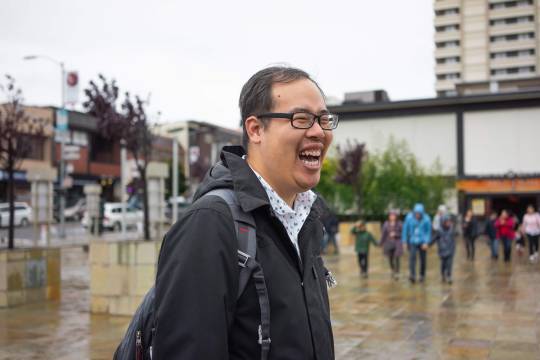
Village
I would like to visit my paternal grandfather's village 隔塘村 (gaak tong cyun) in Zengcheng 增城. I decided to save my paternal grandmother's village 南朗鄉 in Shunde 顺德 for another time, as I have a lot more resources on my paternal grandfather's side than I do for my paternal grandmother.
What do you do for fun?
I like to read, play video games, blog, listen to music and podcasts, bake; go camping, hiking, kayaking; try new foods and explore new places!
How did you hear about Roots?
I've been doing research on my paternal grandfather's side of the family for 5 years now but hit a wall when I tried looking for our home village. As a lot of the resources seemed to focus on the Sze-yap area of 廣東 Province, I wasn't able to do much more and stopped trying to find it.
One day, I was looking for more resources and came across an old website under the Chinese Culture Center, which redirected me to the Him Mark Lai Digital Archive. After some exploring, I found the database of villages in 廣東 with associated surnames, but none of them included my home village.
I thought I had hit yet another brick wall - until I started googling one of the headers in the Digital Archive, "The Roots Program". I quickly found references to the program and old exhibits on a few websites but thought they might have stopped the program because I didn’t see anything recent. Imagine my surprise when I found the Friends of Roots site & the Tumblr blog…!
What are you looking to accomplish?
Growing up my paternal grandparents spoke mostly Cantonese, so I never got to ask them questions about their childhood, how they met, or what it was like to raise a family in Hong Kong, let alone about my ancestors or our home villages. I’m hoping to regain some of these stories from our family through visiting relatives in Hong Kong, where my grandfather’s and father’s generation grew up and paying my respects at family graves across Hong Kong.
Through visiting my paternal great-grandfather’s home village in China, I also hope to regain a sense of identity that our family has since lost. Even though my paternal great-grandparents left the home village to go to Hong Kong in the late 1930’s, my great-grandfather had to leave the family at the start of the war, because the family was afraid something would happen to him in a city under Japanese occupation. Our family never heard from him again, and it was presumed that he had passed away back in the home village. Though my grandfather has been back to the village in the late 2000’s, he didn’t talk much about his trip with the rest of our family, and we don’t have any records where the village may have been.
So, in visiting my home village and reconnecting with whatever family is left there, I hope to learn more about my great-grandfather and grandfather’s generation, as well as reconnect with family still there. I also hope to get a sense of what growing up in the village might have been like for my great-grandfather, what he liked to do, what the village looks like, etc.
What are your expectations?
I don’t have many expectations other than going back, reconnecting with family there, and seeing what the village looks like. My great-grandfather returned to the village in the early 1940s, so I would like to visit his grave if I can. I’ve heard that when my grandfather went back to the village, he rebuilt his father’s tomb at the time.
But I can’t wait to taste all the delicious food in Hong Kong & Guangdong, learn more about overseas Chinese - including those who migrated to Southeast Asia, hopefully, and get a sense for what Southern China is like.
Choose a food that describes you?
Jakarta-style bakmie - It's something that I grew up eating as a part of birthday celebrations, represents both the Chinese & Tionghoa (Chinese Indonesian) sides of my family, & reflects on a range of experiences that I share with others being a part of multiple cultures.
Rachael Tang 鄧安琪
Kathleen Wong 黄玉明
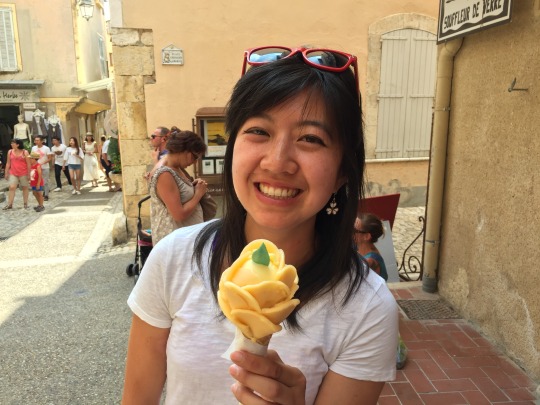
Village Kaiping, Guangdong Province, China. 開平中股鄉赤坎屋上樓村.
What do you do for fun? Rock climbing, running, cooking, and adventuring!
How did you hear about Roots? I heard about Roots through co-founder Al Cheng. My boyfriend introduced me to him as we were having a delicious bun bo hue lunch. At the end of the lunch, Al remarked that I probably have roots in Guangzhou. We connected on Facebook and I saw his program posts. I was intrigued, applied, and the rest is history!
What are you looking to accomplish? After an intimidating visit to Hong Kong in 2011, where I could not demonstrate enough language skills to get around, a visit to China seemed so intimidating. This will be my first trip to the mainland so I’m hoping to get a better understanding of Chinese culture and connect it with my upbringing.
What are your expectations? Good food, good company, and hopefully not too many mosquitos!
Choose a food that describes you? Ice Cream :) Sweet and refreshing!
Jenny Lau 劉健儀
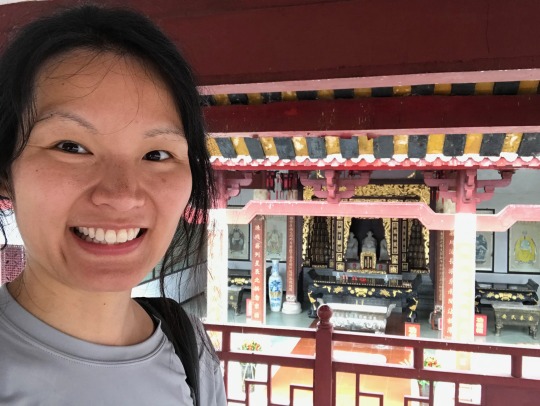
Village
漢塘村 in 台山市省冲蔞镇達材鄉. The village is where my parents were born and raised and also where my paternal grandfather was born and where my maternal grandfather grew up starting around five years old.
What do you do for fun?
I enjoy hanging out with my friends, eating good food, being in nature, exercising, watching movies, sharing stories, being present.
How did you hear about Roots?
I visited the Roots website after seeing a facebook post linking to it from a friend.
What are you looking to accomplish?
I am looking to better understand my parents by visiting the village where they were born and grew up and to imagine what life must have been like for them. I also want to talk to people who might remember my grandparents and have information about them.
What are your expectations?
I would like to connect with my fellow Rooters, hear their stories and why they wanted to do Roots, visit my village with my brother, who is also a Rooter this year, and to see the village that he chose. I would like to learn more about Chinese history, especially when my parents and grandparents were living in China and to contextualize family events within broader Chinese history.
Choose a food that describes you
Some of my staple foods: white rice with laap cheng and chau baak toi thlem (Chinese sausage with stir-fry baby bok choy) and unsweetened Hong Kong (HK) style milk tea. The rice dish appears simple but is very hearty like me, with the right mix of meat/veggies, sweet/savory. At the same time, I am unique in my bold and deep expressions, similar to HK milk tea, which is a unique spin to a classic tea with milk concept but it's particularly bold in flavor because it's double- or multi-brewed and it's full of depth from evaporated/condensed milk.
Michael Tom 譚振豪
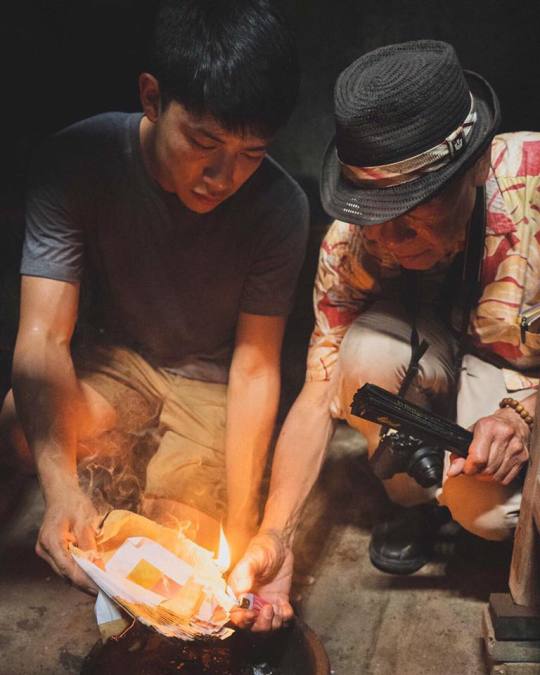
Village: 台山水步毛坪村 (Taishan Shuibu Maoping Village)
What do you do for fun? I like to do indoor bouldering, taking photos, and hanging out with people
How did you hear about Roots?
My cousin, Scott Leung, and my aunt and uncle, Ray and Karen Leung, all went on Roots and recommended that I check it out
What are you looking to accomplish?
I just wanted to see where my grandfather grew up and where my greatgrandfather and greatgrandmother lived
What are your expectations?
I didn't have any expectations because my family hasn't had any communication with the village since for the past 40 years. I went in with an open mind, ready to accept every new experience
.Choose a food that describes you?
Kettle Corn. Savory is serious. Sweet is fun. I'd like to think I'm both, but also 90% hot air.
Angela Yip 叶嘉宝

Village
Wong Cyun in Toisan - 台山 三合 潢村 河清里. This is my paternal great grandfather's village
What do you do for fun?
Eat! There's so much amazing food in the Bay Area. I also love keeping up with my bullet journal, going on hikes, and reading fiction. I've really been enjoying reading books by Asian American female authors lately. Some recent favorites are Chemistry by Weike Wang, Everything I Never Told You by Celeste Ng, and A Place for Us by Fatima Fahreen Mirza.
How did you hear about Roots?
I heard about Roots from my mom's cousin's wife Liana Koehler, Roots alum and Roots lecturer. It came up in conversation at dinner after my grandpa's funeral. She said I had to do Roots, and I was immediately sold. Roots came at the perfect time.
What are you looking to accomplish?
I am hoping to learn more about a side of my family that I don't know much about--my paternal grandma's side. I grew up extremely close to my grandma, and I want to be able to show her pictures of her father's village because she was never able to visit. I also just want to learn more about Toisan, even basic information like what people eat and grow and what they do for fun. Both sides of my family are from Toisan, so it has shaped my family and my experience of being Chinese in the US in huge ways, but I know very little about the region.
What are your expectations?
I hope to find the right village! Other than that, I am trying to approach my rooting with little expectation and to stay open to whatever might happen. I expect it to be an emotional experience for me for sure.
Choose a food that describes you?
Fried rice from Fung Wah on Mission Street in Daly City
Jeffrey Lau 劉健仁

Village: I'm visiting my paternal grandma's village of 衝洋向南村
What do you do for fun? I hang with people that are easier for me to hang with for fun.
How did you hear about Roots? I learned about Roots two years ago from a friend's Facebook feed! I marinated on the idea of applying until I actually did.
What are you looking to accomplish? I’m looking to reflect on my relationships with family members who’ve had the most direct impact on my life—like the one with my paternal grandma, who raised me. I want this trip, in the long run, support my process of grounding more of my life in my Chinatown organizing work.
What are your expectations? My expectations are simply to get a feel and look of where my grandma grew up. She don't tell me much herself, so I’m gonna discover more about her myself.
Choose a food that describes you? I'm gonna say fries. Fries done well are golden and crispy, but get kinda whack over time as they get soggier. I usually start strong in many things but my energy dips over time and some times I'm kinda whack towards the end, haha...
Hannah Yee 余壽玉

Village - Dick Hoi, Toisan
Fun - I dance, garden, bake, and love being in the outdoors
Hear about Roots - Through my sister who found out through social media haha
Accomplish - (?) in life? in roots? - For Roots I wanted to accomplish finding my village, seeing the school I have heard so much about, and finding a base of friends who want to explore their Chinese American identities together and eat good food together. Expectations - I didn't know what to expect from this program. I expected it would be exciting, rigorous, tiring, and fun. I also expected it to be like solving a mystery/Clue/puzzle
Food - Dung/Jung - Have to open up the leaves to enjoy the inside! Filled with surprises like peanuts, lup cheong, egg, etc. Warm, comfort food that is a classic! Picture - I'll send you one once I get home!
Fiona Wong 黃寶賢
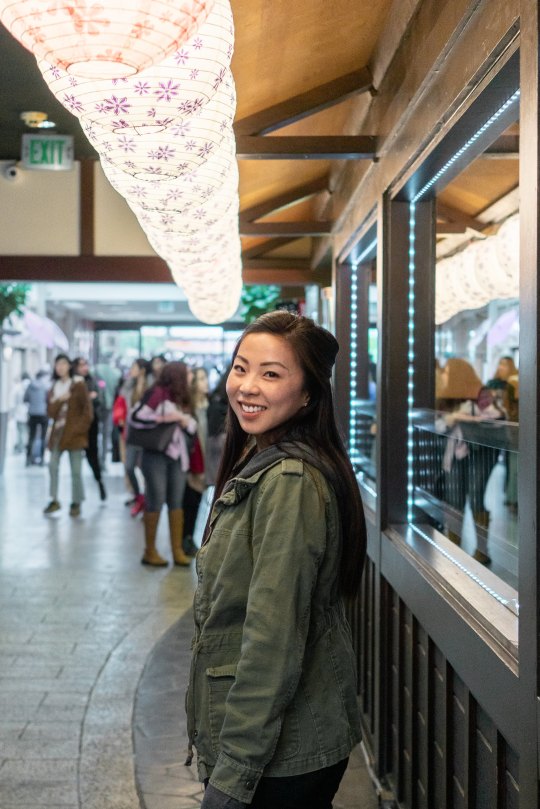
1. Village
中國廣東省台山市白沙鎮潮境众亨鄉潮興里
Bak Sa, Toishan
2. What do you do for fun?
I enjoy exploring new places, trying new things, and checking things off my to-do/travel bucket list during my free time. I love spending quality time with friends and family while having delicious food. As long as it is a day with blue skies, I do not mind what I'm doing as long as I'm outside!
3. How did you hear about roots?
I heard about roots through a friend who went on this program and shared her experience through social media.
4. What are you looking to accomplish?
I am looking to dive deeper into the history of China and Chinese immigration to the states with emphasis on Cantonese and Toishanese context. I am excited about the opportunity to visit other villages in the Pearl Delta River Region and to return to my ancestral village.
5. What are you expectations?
I did not have much expectations going in other than hoping that our cohort will support one another wholeheartedly.
6. Choose a food that describes you
Some type of dish that has onions because I have a lot of layers.
Nicole Wong 王雅斯

Village
I'm visiting my paternal great grandfather's village: 江門市蓬江區荷塘镇三丫沙滘村.
What do you do for fun?
I love to cook food and sing with friends, join the occasional pick-up soccer game, try different dance classes, read, and get outside.
How did you hear about Roots?
I first learned about Roots from my mom, but it wasn't until I heard Steve Owyang speak about the program at a CAA anniversary dinner that I seriously considered applying.
What are you looking to accomplish?
To learn more about my family's history so I can understand myself better and connect more deeply with my Chinese heritage.
What are your expectations?
To meet my Xinhui relatives and see the village, old house, house, and gravesite of my ancestors.
Choose a food that describes you?
Peanut butter (because I love it and chew on ideas/questions for a while
1 note
·
View note
Text
youtube

THE BASIC BRIEF – OCTOBER 22ND, 2021
In this week’s Basic Brief, we highlight the reconciliation bill getting cut down, Manchin potentially leaving the Democratic Party, Colin Powell passing away, and more. Also linked is all the content from The People’s Basics this week.
JOE MANCHIN CONSIDERING LEAVING THE DEMOCRATIC PARTY
By David Corn – Mother Jones October 20th, 2021
“In recent days, Sen. Joe Manchin (D-W.Va.) has told associates that he is considering leaving the Democratic Party if President Joe Biden and Democrats on Capitol Hill do not agree to his demand to cut the size of the social infrastructure bill from $3.5 trillion to $1.75 trillion, according to people who have heard Manchin discuss this.”

DEMOCRATS CUTTING DOWN RECONCILIATION BILL
By Margot Sanger-Katz and Alicia Parlapiano – NY Times October 20th, 2021
“As Democrats in Congress debate how to pare back their big social spending bill — to a total budget increase of less than $2 trillion over a decade — they have even further to go than it may appear.”
NIKOLAS CRUZ PLEADS GUILTY TO 2018 PARKLAND SCHOOL MASSACRE
By Terry Spencer – AP News October 20th, 2021
“Nikolas Cruz pleaded guilty Wednesday to murdering 17 people during a rampage at his former high school in Parkland, Florida, leaving a jury to decide whether he will be executed for one of the nation’s deadliest school shootings.”

COLIN POWELL PASSES AWAY
By Devan Cole – CNN October 19th, 2021
“Colin Powell, the first Black US secretary of state whose leadership in several Republican administrations helped shape American foreign policy in the last years of the 20th century and the early years of the 21st, has died from complications from Covid-19, his family said on Facebook. He was 84.”

BIDEN HAS THE POWER TO PREVENT 1.6 BILLION METRIC TONS OF EMISSIONS ANNUALLY
By Joseph Winters – Grist October 15th, 2021
“Hundreds of Indigenous protesters and environmental advocates descended on Washington, D.C. this week to demand that President Joe Biden use his executive authority to nix new fossil fuel projects and declare a climate emergency. Every day since Monday — Indigenous Peoples’ Day — they’ve marched, chanted, and engaged in civil disobedience outside the Capitol and White House.”
HUMAN REMAINS FOUND IN FLORIDA RESERVE CONFIRMED TO BE BRIAN LAUNDRIE
By Doha Madani and Pei-Sze Cheng – NBC News October 21st, 2021
“Partial remains found by authorities searching for Brian Laundrie, Gabby Petito’s fiancé, were confirmed to be his after a review of dental records.”
CRIMINAL JUSTICE DATA SHOWS NEBRASKANS ARE SERVING LONGER SENTENCES IN PRISON
By Bayley Bischof – 1011now October 19th, 2021
“Nebraska’s prisons remain in an overcrowding emergency, at the same time they’re seeing critical staff shortages.
It’s a combination that has lawmakers, corrections staff and the loved ones of inmates calling for change.”

COMPLIANCE WITH VACCINE MANDATE FOR CITY EMPLOYEES WORTH AMONG POLICE, FIREFIGHTERS
By Fran Spielman and Mitch Dudek – Chicago Suntimes October 18th, 2021
“Out of 12,770 CPD employees, 4,543 had failed to report their vaccine status by the midnight Friday deadline. On Monday, employees who have defied the mandate were being called in by their supervisors and given one last chance to report their vaccine status on the city’s portal.”
NEARLY 80% OF REPUBLICANS WANT TO SEE TRUMP RUN IN 2024
By Tal Axelrod – The Hill October 19th, 2021
“Nearly 80 percent of Republicans want to see former President Trump wage a third White House bid in 2024, according to a new Quinnipiac University survey released Tuesday.”

MANCHIN TAKES AIM AT BIDEN’S CLIMATE CHANGE AGENDA
By Zachary B Wolf – CNN October 20th, 2021
“West Virginia Sen. Joe Manchin — a Democrat — appears to be intent on ripping the heart out of President Joe Biden’s climate change agenda.”
#the peoples basics#politics#discussion#basic brief#democracy & government#human-centered economics#Current Affairs/ Current News#Youtube
0 notes
Text
Chile Oil Is So Hot Right Now

Chile oil is very much on trend. | sasaken/Shutterstock
As chefs and restaurateurs create their own versions of the condiment, chile oil has reached cult status here in the States
Back in 2011, shortly after taking ownership of the 100-year-old Nom Wah Tea Parlor, Wilson Tang wanted to sell jars of branded chile oil. But his first batch did not meet the labeling requirements for bottled products according to the Department of Health, and he shelved the idea in order to focus on the restaurant’s bread and butter: in-house diners.
Nearly 10 years later, Tang came back around to the idea. “We had everything ready to launch right before we closed up operations for COVID-19,” says Tang. He released Nom Wah’s first batch of chile oil on the restaurant’s webstore, and it sold out within hours. Once operations are back up and running, Tang hopes to sell the product again, in Nom Wah restaurants and online.
Today, he finds himself in the company of other restaurants and small businesses selling a signature bright vermilion, sediment-thick chile oil. Tang says he was even inspired by fellow young, New York-based entrepreneurs, including Eric Sze of 886 and Lucas Sin of Junzi Kitchen, who each offer branded chile oil that was for sale in their restaurants’ physical locations before they closed to in-house diners due to the coronavirus. (Sze Daddy, the chile oil from 886, was available online but has sold out; Junzi’s chile oil can still be purchased online.) San Francisco’s acclaimed Chinese restaurant Mr. Jiu’s has its own Chile Crisp Sauce, part of a lineup of sauces in partnership with Williams-Sonoma. Jason Wang, owner of the New York City chain Xi’an Famous Foods, which specializes in the cuisine of the western Chinese province of Shaanxi, also recently began to sell signature chile oil packets, by popular demand.
“I saw someone drinking it once,” says Wang, of his chile oil, before he made the decision to sell the packets separately. “People were saying, ‘I’m going to send this to my friend across the country.’” All locations of Xi’an Famous Foods are currently closed due to the coronavirus, but the chile oil can still be purchased online.
None of these business owners could have predicted that their chile oils would become vestiges of an experience that’s no longer available — dining at their establishment — for the lucky customers who bought them. They were intended to leave visitors with a lingering aftertaste and remind them to come back soon. According to Sze, who estimates that 886 sold about 60 jars per week when it was open, “A lot of people finish their meal and are like, ‘I’ll take a jar.’”
Now, as the timeline for reopening remains blurry, retail items from restaurants have become a hot ticket, and shelf-stable chile oils have been anointed a pandemic pantry must-have for those longing to give their home-cooked creations a whiff of spicy-restaurant nostalgia. But what is chile oil? What does it have to do with “chile crisp��? And why is everyone seemingly crazy for spicy, chunky, oily hot sauce in the first place?
When it comes to chile oil — or “chile crisp” — the first thing that pops into many people’s minds nowadays is Lao Gan Ma, a mass-produced, Chinese brand of chile sauce that’s gained a cult following in the United States. Inexpensive and widely available, its Spicy Chili Crisp condiment in particular — which some fans simply call Lao Gan Ma — is so popular that it’s increasingly seen as a benchmark for oil-based chile condiments, and the prototype that some restaurants have looked to to set their versions against. “Lao Gan Ma has too much of a monopoly. We wanted to offer something a little different,” says Sze.
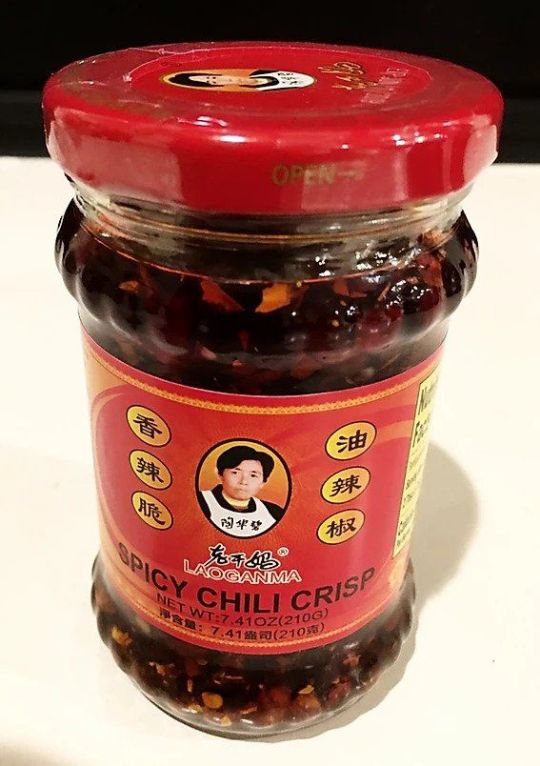
Lao Gan Ma [official]
The Chinese chile sauce brand Lao Gan Ma makes a spicy chili crisp.
However, there is some confusion over what exactly “chile crisp” means, and if it’s an entirely different type of product from chile oil, or a variation. “I’ve actually had Chinese friends who were like, ‘What’s chile crisp? Oh, it’s chile oil?’” says Lisa Cheng-Smith, founder of Yun Hai, an exporter of small-batch sauces from Taiwan. A condiment from a small Sichuan-Taiwanese maker called Su Spicy Chili Crisp was the first product available through her ecommerce business, and its best-seller. And while it’s been made for generations, Cheng-Smith gave it a new, English name for its U.S. debut. “I didn’t start calling it ‘chile crisp’ until I started selling it. I always just called it ‘chile oil,’” says Cheng-Smith.
“Lao Gan Ma has five different products, and only one is called Spicy Chili Crisp,” says Jenny Gao, founder of Fly By Jing, a brand of Sichuan ingredients with a signature product called Sichuan Chili Crisp. She says that she was taking cues from other references of the term “chili crisp” when she decided to name her product Sichuan Chili Crisp — in particular, a recipe for chile crisp in the Mission Chinese Food cookbook, published in 2015. That recipe, by Danny Bowien and Chris Ying, is inspired by Lao Gan Ma, “our favorite brand of the stuff,” the authors write. But it’s also a two-part recipe for “Chili Crisp and Chili Oil,” whereby the latter is produced simply by straining out the solids from the infused oil.
Products called “chile crisp” as opposed to chile oil typically have a higher ratio of particles in them than oil. Those particles are the chile flakes (and often garlic, shallots and any number of other ingredients and spices) that are sizzled in the oil to infuse it, becoming crispy in the process. This textural component is what many find irresistible about Sichuan Chili Crisp, Spicy Chili Crisp, and similar high-particle oils. They’re also typically seasoned with salt, soy sauce, MSG, and occasionally fish sauce or other savory agents like fermented black beans.
“I consider chile oil like soy sauce, in that it’s a cooking ingredient,” says Gao. “I view the chunky Spicy Chili Crisp from Lao Gan Ma and my Sichuan Chili Crisp as a condiment — I rarely cook with it; I use it as a topping.”
But in reality, these roles are not so strict, and one person’s idea of a cooking ingredient may be another’s condiment. “You can cook with dried chile pepper flakes and you can also just scatter it on pizza,” says Gao.
“Chile crisp”-labeled oils can still vary a lot in taste, too; Cheng-Smith thinks that Lao Gan Ma’s Spicy Chili Crisp is saltier and more laden with MSG than others — the product is “good in a junk food-y way.”
But whether it’s called a crisp or an oil, the idea of a spicy, chile-based topping that isn’t a vinegar-based sauce has little precedent in the U.S. For generations, when Americans wanted to kick up their entrees with a little extra heat, they dabbled thin, red droplets of a pepper sauce. There are thousands of sauces like this: cayenne- or habanero-based; red, green, or yellow; with the addition of fruit for balance or adorned with grim reapers on their labels. And while fierce proponents of Crystal and Frank’s Red Hot may argue about how much these sauces differ, when it comes to the general style, they don’t.
The taste for vinegar-based chile sauce is, of course, not just limited to Americans. The Southeast Asian chile sauce sambal olek is similarly bright and tangy, with a smack of fresh garlic, although it’s chunky in composition. Sriracha, a smoother, thicker, sweeter chile sauce created by a Vietnamese American in California, is also vinegar-based, with no oil to speak of.
A chile condiment that is not only oily but earthy, toasty, and cooked rather than highly acidic and fresh-tasting is still something of a novelty, found in Asian groceries or from the beloved restaurants that sell theirs. Walk down a typical American supermarket’s hot sauce aisle and you probably won’t find anything like it.
But as Tang saw it, with Chinese food more mainstream than ever, the time was right to sell Nom Wah chile oil. And, as he and other restaurateurs profess, a great deal of customers request a chile condiment with their food. Sriracha, Cholula, and other vinegary sauces are not the right complement for everything.
“You wouldn’t take out Tabasco and douse it on Chinese food because it doesn’t go together,” says Gao. “But with oil-based sauce, it’s just a better fit for Chinese cuisine.”
For more than a century, milder cuisines from China dominated the Chinese food enjoyed in the United States. That began to change after the U.S. lifted restrictions on immigration from China in 1965. Before then, the first waves of immigrants from China, who created the canon of Chinese-American staples like chop suey and egg foo young, were Toisanese, from Guangdong Province, whose traditional cuisine employs little to no spice. Much later on, Cecilia Chiang’s San Francisco restaurant the Mandarin introduced Americans to Northern Chinese cuisine, like Peking duck, which also happens to not be very spicy. After the floodgates were lifted, chile-laden cuisines from all around Asia brought new meaning to the word “hot.”
But before these cuisines reached the states, a taste for spice spread within China. “Chile peppers didn’t even arrive in China until 200 years ago,” says Gao, whose hometown is Chengdu, Sichuan province’s capital. “They arrived in the East... then slowly moved throughout China, and it took off in Sichuan because of the climate.” Many other parts of China, such as Hunan Province, also boldly employ chile peppers, but Gao says that Sichuan food is so well-known in China and throughout the world because its cuisine is all about complex flavor combinations, like ma la — the combination of chile heat and numbing spice from Sichuan peppercorns. “There’s dozens of flavor profiles in Sichuan cuisine; their chefs have really mastered what flavor can be.”
Diana Kuan, author of Red Hot Kitchen, a cookbook focused on the many varieties of Asian hot sauces, lived in China from 2007 to 2009 and witnessed the rising popularity of Sichuan cuisine in the country, especially in Beijing, where she was based. For the last few decades, as people — such as the laborers from the countryside who helped build China’s modern cities — migrated within the country, their cuisines mingled. “I think people are beginning to like spicy food more in southern China and Hong Kong, so there will be a little dish of chile sauce to go with dim sum,” she says. “In every city you can find some sort of spicy cuisine, so nowadays it’s pretty much ubiquitous.”
Hence, chile oil is not just enjoyed in Sichuan Province, where it would typically receive a touch of Sichuan peppercorn. Lao Gan Ma is, after all, a brand from Guizhou Province, whose signature flavor combo is a spicy and sour; Xi’an Famous Foods’ chile oil has distinct spices from China’s western provinces, including cumin; Su Spicy Chili Crisp has a scattering of sesame seeds; 886’s Sze Daddy sauce nods to the Taiwanese condiment sha-cha sauce, which has a touch of sweetness; and Nom Wah’s chile oil is a simple infusion of dried chiles and oil.
“Some regions might use fermented soybeans… in the Guangdong region they make theirs often with peanuts,” says Lucas Sin, chef-owner of Junzi Kitchen. The methodology differs, too. Sin, a 2019 Eater Young Gun, says that the different terminology throughout China used for these oils can offer clues into how they are made.
“Hong you,” which translates to “red oil,” is what many people in China, such as in Sichuan province, would typically call chile oil. Another generic term for chile oil used throughout China is “la jiao you” — which translates directly to “hot pepper oil.”
“We actually make you po la zi,” says Sin. He explains the character for “po” denotes the act of pouring the oil over something. (One might translate this term to “spicy pour-over oil.”)
Junzi’s signature chile oil employs this simple pour-over method: you take your spices and aromatics, place them in a heatproof vessel, and pour sizzling-hot oil over them at once. Other chile oils, such as Fly By Jing’s and 886’s, for instance, employ a longer cooking process where the chiles and aromatics are added in sequence, and cooked until the whole concoction is toasted and infused just so.
But, just like their English counterparts, these Chinese terms are often used interchangeably. And there are ever newer terms and variations being invented for a similar crispy, chunky, oil-y chile product. The grocer Trader Joe’s, for instance, makes a particle-rich chile condiment called Chili Onion Crunch.
Every cook, restaurant, and producer lends their own creative spin to this rudimentary vehicle for spice and flavor. Sin describes his dad’s famous homemade chile oil — something that he’s “kind of famous for” in his circle of friends and family. He dices the garlic by hand and simmers it slow and low for hours along with dried chiles and sesame seeds. There’s a lot of room for creativity, says Sin. “Most likely, we just make the chile oil that tastes the best to us.”
Cathy Erway is the author of The Food of Taiwan: Recipes From the Beautiful Island and The Art of Eating In: How I Learned to Stop Spending and Love the Stove.
from Eater - All https://ift.tt/2VZlvFt https://ift.tt/2KXu65l

Chile oil is very much on trend. | sasaken/Shutterstock
As chefs and restaurateurs create their own versions of the condiment, chile oil has reached cult status here in the States
Back in 2011, shortly after taking ownership of the 100-year-old Nom Wah Tea Parlor, Wilson Tang wanted to sell jars of branded chile oil. But his first batch did not meet the labeling requirements for bottled products according to the Department of Health, and he shelved the idea in order to focus on the restaurant’s bread and butter: in-house diners.
Nearly 10 years later, Tang came back around to the idea. “We had everything ready to launch right before we closed up operations for COVID-19,” says Tang. He released Nom Wah’s first batch of chile oil on the restaurant’s webstore, and it sold out within hours. Once operations are back up and running, Tang hopes to sell the product again, in Nom Wah restaurants and online.
Today, he finds himself in the company of other restaurants and small businesses selling a signature bright vermilion, sediment-thick chile oil. Tang says he was even inspired by fellow young, New York-based entrepreneurs, including Eric Sze of 886 and Lucas Sin of Junzi Kitchen, who each offer branded chile oil that was for sale in their restaurants’ physical locations before they closed to in-house diners due to the coronavirus. (Sze Daddy, the chile oil from 886, was available online but has sold out; Junzi’s chile oil can still be purchased online.) San Francisco’s acclaimed Chinese restaurant Mr. Jiu’s has its own Chile Crisp Sauce, part of a lineup of sauces in partnership with Williams-Sonoma. Jason Wang, owner of the New York City chain Xi’an Famous Foods, which specializes in the cuisine of the western Chinese province of Shaanxi, also recently began to sell signature chile oil packets, by popular demand.
“I saw someone drinking it once,” says Wang, of his chile oil, before he made the decision to sell the packets separately. “People were saying, ‘I’m going to send this to my friend across the country.’” All locations of Xi’an Famous Foods are currently closed due to the coronavirus, but the chile oil can still be purchased online.
None of these business owners could have predicted that their chile oils would become vestiges of an experience that’s no longer available — dining at their establishment — for the lucky customers who bought them. They were intended to leave visitors with a lingering aftertaste and remind them to come back soon. According to Sze, who estimates that 886 sold about 60 jars per week when it was open, “A lot of people finish their meal and are like, ‘I’ll take a jar.’”
Now, as the timeline for reopening remains blurry, retail items from restaurants have become a hot ticket, and shelf-stable chile oils have been anointed a pandemic pantry must-have for those longing to give their home-cooked creations a whiff of spicy-restaurant nostalgia. But what is chile oil? What does it have to do with “chile crisp”? And why is everyone seemingly crazy for spicy, chunky, oily hot sauce in the first place?
When it comes to chile oil — or “chile crisp” — the first thing that pops into many people’s minds nowadays is Lao Gan Ma, a mass-produced, Chinese brand of chile sauce that’s gained a cult following in the United States. Inexpensive and widely available, its Spicy Chili Crisp condiment in particular — which some fans simply call Lao Gan Ma — is so popular that it’s increasingly seen as a benchmark for oil-based chile condiments, and the prototype that some restaurants have looked to to set their versions against. “Lao Gan Ma has too much of a monopoly. We wanted to offer something a little different,” says Sze.

Lao Gan Ma [official]
The Chinese chile sauce brand Lao Gan Ma makes a spicy chili crisp.
However, there is some confusion over what exactly “chile crisp” means, and if it’s an entirely different type of product from chile oil, or a variation. “I’ve actually had Chinese friends who were like, ‘What’s chile crisp? Oh, it’s chile oil?’” says Lisa Cheng-Smith, founder of Yun Hai, an exporter of small-batch sauces from Taiwan. A condiment from a small Sichuan-Taiwanese maker called Su Spicy Chili Crisp was the first product available through her ecommerce business, and its best-seller. And while it’s been made for generations, Cheng-Smith gave it a new, English name for its U.S. debut. “I didn’t start calling it ‘chile crisp’ until I started selling it. I always just called it ‘chile oil,’” says Cheng-Smith.
“Lao Gan Ma has five different products, and only one is called Spicy Chili Crisp,” says Jenny Gao, founder of Fly By Jing, a brand of Sichuan ingredients with a signature product called Sichuan Chili Crisp. She says that she was taking cues from other references of the term “chili crisp” when she decided to name her product Sichuan Chili Crisp — in particular, a recipe for chile crisp in the Mission Chinese Food cookbook, published in 2015. That recipe, by Danny Bowien and Chris Ying, is inspired by Lao Gan Ma, “our favorite brand of the stuff,” the authors write. But it’s also a two-part recipe for “Chili Crisp and Chili Oil,” whereby the latter is produced simply by straining out the solids from the infused oil.
Products called “chile crisp” as opposed to chile oil typically have a higher ratio of particles in them than oil. Those particles are the chile flakes (and often garlic, shallots and any number of other ingredients and spices) that are sizzled in the oil to infuse it, becoming crispy in the process. This textural component is what many find irresistible about Sichuan Chili Crisp, Spicy Chili Crisp, and similar high-particle oils. They’re also typically seasoned with salt, soy sauce, MSG, and occasionally fish sauce or other savory agents like fermented black beans.
“I consider chile oil like soy sauce, in that it’s a cooking ingredient,” says Gao. “I view the chunky Spicy Chili Crisp from Lao Gan Ma and my Sichuan Chili Crisp as a condiment — I rarely cook with it; I use it as a topping.”
But in reality, these roles are not so strict, and one person’s idea of a cooking ingredient may be another’s condiment. “You can cook with dried chile pepper flakes and you can also just scatter it on pizza,” says Gao.
“Chile crisp”-labeled oils can still vary a lot in taste, too; Cheng-Smith thinks that Lao Gan Ma’s Spicy Chili Crisp is saltier and more laden with MSG than others — the product is “good in a junk food-y way.”
But whether it’s called a crisp or an oil, the idea of a spicy, chile-based topping that isn’t a vinegar-based sauce has little precedent in the U.S. For generations, when Americans wanted to kick up their entrees with a little extra heat, they dabbled thin, red droplets of a pepper sauce. There are thousands of sauces like this: cayenne- or habanero-based; red, green, or yellow; with the addition of fruit for balance or adorned with grim reapers on their labels. And while fierce proponents of Crystal and Frank’s Red Hot may argue about how much these sauces differ, when it comes to the general style, they don’t.
The taste for vinegar-based chile sauce is, of course, not just limited to Americans. The Southeast Asian chile sauce sambal olek is similarly bright and tangy, with a smack of fresh garlic, although it’s chunky in composition. Sriracha, a smoother, thicker, sweeter chile sauce created by a Vietnamese American in California, is also vinegar-based, with no oil to speak of.
A chile condiment that is not only oily but earthy, toasty, and cooked rather than highly acidic and fresh-tasting is still something of a novelty, found in Asian groceries or from the beloved restaurants that sell theirs. Walk down a typical American supermarket’s hot sauce aisle and you probably won’t find anything like it.
But as Tang saw it, with Chinese food more mainstream than ever, the time was right to sell Nom Wah chile oil. And, as he and other restaurateurs profess, a great deal of customers request a chile condiment with their food. Sriracha, Cholula, and other vinegary sauces are not the right complement for everything.
“You wouldn’t take out Tabasco and douse it on Chinese food because it doesn’t go together,” says Gao. “But with oil-based sauce, it’s just a better fit for Chinese cuisine.”
For more than a century, milder cuisines from China dominated the Chinese food enjoyed in the United States. That began to change after the U.S. lifted restrictions on immigration from China in 1965. Before then, the first waves of immigrants from China, who created the canon of Chinese-American staples like chop suey and egg foo young, were Toisanese, from Guangdong Province, whose traditional cuisine employs little to no spice. Much later on, Cecilia Chiang’s San Francisco restaurant the Mandarin introduced Americans to Northern Chinese cuisine, like Peking duck, which also happens to not be very spicy. After the floodgates were lifted, chile-laden cuisines from all around Asia brought new meaning to the word “hot.”
But before these cuisines reached the states, a taste for spice spread within China. “Chile peppers didn’t even arrive in China until 200 years ago,” says Gao, whose hometown is Chengdu, Sichuan province’s capital. “They arrived in the East... then slowly moved throughout China, and it took off in Sichuan because of the climate.” Many other parts of China, such as Hunan Province, also boldly employ chile peppers, but Gao says that Sichuan food is so well-known in China and throughout the world because its cuisine is all about complex flavor combinations, like ma la — the combination of chile heat and numbing spice from Sichuan peppercorns. “There’s dozens of flavor profiles in Sichuan cuisine; their chefs have really mastered what flavor can be.”
Diana Kuan, author of Red Hot Kitchen, a cookbook focused on the many varieties of Asian hot sauces, lived in China from 2007 to 2009 and witnessed the rising popularity of Sichuan cuisine in the country, especially in Beijing, where she was based. For the last few decades, as people — such as the laborers from the countryside who helped build China’s modern cities — migrated within the country, their cuisines mingled. “I think people are beginning to like spicy food more in southern China and Hong Kong, so there will be a little dish of chile sauce to go with dim sum,” she says. “In every city you can find some sort of spicy cuisine, so nowadays it’s pretty much ubiquitous.”
Hence, chile oil is not just enjoyed in Sichuan Province, where it would typically receive a touch of Sichuan peppercorn. Lao Gan Ma is, after all, a brand from Guizhou Province, whose signature flavor combo is a spicy and sour; Xi’an Famous Foods’ chile oil has distinct spices from China’s western provinces, including cumin; Su Spicy Chili Crisp has a scattering of sesame seeds; 886’s Sze Daddy sauce nods to the Taiwanese condiment sha-cha sauce, which has a touch of sweetness; and Nom Wah’s chile oil is a simple infusion of dried chiles and oil.
“Some regions might use fermented soybeans… in the Guangdong region they make theirs often with peanuts,” says Lucas Sin, chef-owner of Junzi Kitchen. The methodology differs, too. Sin, a 2019 Eater Young Gun, says that the different terminology throughout China used for these oils can offer clues into how they are made.
“Hong you,” which translates to “red oil,” is what many people in China, such as in Sichuan province, would typically call chile oil. Another generic term for chile oil used throughout China is “la jiao you” — which translates directly to “hot pepper oil.”
“We actually make you po la zi,” says Sin. He explains the character for “po” denotes the act of pouring the oil over something. (One might translate this term to “spicy pour-over oil.”)
Junzi’s signature chile oil employs this simple pour-over method: you take your spices and aromatics, place them in a heatproof vessel, and pour sizzling-hot oil over them at once. Other chile oils, such as Fly By Jing’s and 886’s, for instance, employ a longer cooking process where the chiles and aromatics are added in sequence, and cooked until the whole concoction is toasted and infused just so.
But, just like their English counterparts, these Chinese terms are often used interchangeably. And there are ever newer terms and variations being invented for a similar crispy, chunky, oil-y chile product. The grocer Trader Joe’s, for instance, makes a particle-rich chile condiment called Chili Onion Crunch.
Every cook, restaurant, and producer lends their own creative spin to this rudimentary vehicle for spice and flavor. Sin describes his dad’s famous homemade chile oil — something that he’s “kind of famous for” in his circle of friends and family. He dices the garlic by hand and simmers it slow and low for hours along with dried chiles and sesame seeds. There’s a lot of room for creativity, says Sin. “Most likely, we just make the chile oil that tastes the best to us.”
Cathy Erway is the author of The Food of Taiwan: Recipes From the Beautiful Island and The Art of Eating In: How I Learned to Stop Spending and Love the Stove.
from Eater - All https://ift.tt/2VZlvFt via Blogger https://ift.tt/3dlcoF3
0 notes
Text
Ending and Thoughts: Forensic Heroes 4
TVB’s grand production drama. Where it has a high budget with a stellar cast, also filmed overseas and use of popular actors & actresses in cameo case roles. Unfortunately TVB decided to air it early in February which is far from the “golden time” to air series. I’m not that surprised with the situation. But I’m sure the biggest reason is cause half of the cast aren’t people TVB wants to promote anymore. Selena Li - Contract ended and signed with an American talent agency. Raymond Wong - Contract ended signed with Louis Koo’s company. Alice Chan- Decided to take a break on filming to focus more on personal life. Rebecca Zhu- Got backlashed from voicing out how uncomfortable she is around Tony Hung. Second reason would be the producer Miu Si Chun has retired and this will be her last series. But airing it so early actually backfired for them as this was aired during the covid- 19 situation where basically everyone stayed home. Because of this thousands of people tuned into this drama. It got super high ratings and has the highest average watchers for a drama that TVB has not seen in years!! So their plan to air it early backfired so badly for them.
Honestly, this drama wasn’t that good. The cases were either boring or predictable. The only case that kept me on my feet was the mother- long lost son case. Other than that the cases were bad. Which sucked cause these cases had so much potential to do better but the writing sucked! I can’t explain how disappointed I am that the cases were so easy for us to guess who did it. And some guest stars were wasted on this drama. Yumiko Cheng, Sharon Chan, Nina Paw and Patrick Tse are some examples of useless characters that didn’t need to be there. Also the character development was so poorly done that I’m just stuck here wondering if the cutting of Jacqueline Wong effected the drama so much that it ended up being choppy!
Charm Ting (Fred Cheng) is considered a main character but he seemed more like a kelefe. Which is hilarious cause in the first Forensic Heroes he had a bigger role there than here. He’s literally in the background where he would say 1 or 2 lines and then disappears. He was there just to be a love interest to Ko Ching (Rebecca Zhu) which was pointless cause her role is super small as well. We don’t even know when they even started dating. They were barely seen together. Charm has admitted to having a crush on Ko Ching but that’s it. Ko Ching never seemed interested in him until the end where they’re magically dating. The writer focused way too much on adding nonsensical characters when they should be focusing on the main ones! Monique Hau (Yumiko Cheng) isn’t needed at all. I thought maybe half way through she would die or she kills someone but no she was just there to date Ko On (Raymong Wong) and then dumps him when her first love comes back. Like why? Why bother inviting Yumiko for such a stupid role? Instead of Ko On wasting his time for this stand in girlfriend they should’ve focused more on her budding relationship with Chris Tsui (Roxanne Tong). Cause when he got together with her in the end it made no sense whatsoever. I actually thought I missed an episode because of how random it was. The last we saw is Chris tracking Ko Ons biological sister. They were friends at that time and remained that way until the end where somehow Chris fell for Ko On despite never showing that and vice versa. Like I’m not even sure which relationship was more out of the blue? Charm/ Ko Ching or Ko On/Chris? The only relationship that’s worth getting invested in is between Man Ka Hei (Selena Li) and Stan Sze (Gabriel Harrison). Seriously they were the only couple that actually slowly built up towards being something more and they had crazy good chemistry together which you can’t see from any of the other couples at all! Which brings me to Queen Sui (Alice Chan) and King Kwok (Shaun Tam). Boy their chemistry was the worst!! You feel absolutely nothing for them. It was like watching two blocks of wood dating. And the best part? These two who had the worst chemistry ends up the one getting married! Wooooooow. I feel like the problem though lies on the actress Alice. She’s a good actress, she’s amazing when it comes to villain roles but when it comes to love relationships she fails at it. It might have to do with how her real life relationship didn’t work out. She mentioned that she was in a loveless relationship with her husband. But they were both were too scared to leave each other and cause of that they prolonged a relationship that never got better. So I’m convinced it’s due to this,that it’s harder for her to portray these romance scenes.
The uneven screentime between the leads got me thinking of how detrimental the refilming of Jacqueline was. Chris ends up getting involved with the forensic cast in the first place cause she rented a room from King Sir. In that apartment she also shares it with Charm. I’m like 99% sure they cut out those “roommate” scenes, which you’d think “eh it’s filler scenes, it doesn’t matter”. But it’s cause they cut those, Fred ends up getting heavily downgraded! Also if they were just gonna have Chris basically not interact with the forensic team, they shouldn’t have bothered to have her move into their apartment then. Cause it didn’t advance the plot and was just a waste of time. Chris was a heavy character in the beginning but then disappeared drastically until near the end. The storyline started off amazingly good too! Chris was the reason why Ko On’s sister Ko Seen (Kelly Cheung) ended up getting kidnapped. It’s cause of this she becomes a journalist to find Ko On and Ko Seen. She was extremely remorseful and worked hard to find Ko Seen. Which is why I was pissed when after she was found, Chris never met her. They never interacted. A scene where Chris apologizes to her face to face would’ve been super nice. I can’t help but also believe that chances are it was in the script but they couldn’t have Roxanne film it with Kelly probably due to scheduling conflicts.
The ending case should be the best one. The one where it’ll keep us on our toes. It didn’t and was also a downer. Sharon Chan who guest stars as Lam Ka Mei was also a waste of a role. Though Sharon did amazing playing a split personality character, it never went into depth how it happened. Generally, this disorder happens if the character herself experiences a high trauma where they go into hiding and another “stronger” person comes out. This case was also the first time where Ka Mei “killed”. I’m assuming this disorder happened due to her older sisters death? The problem lies on how her sister died 7-8 years ago, yet this is the first time her other side came out and also the first time she killed. According to Ka Mei herself, this was the first time she felt something was wrong with her. After all these years her disorder comes out now? Okay. Anyways she gets locked up in a mental hospital cause she did kill someone even if she’s just a copy cat killer.
The real criminal ended up being Michael Ma (Jonathon Cheung) who happens to be Ko Seens adoptive brother. Basically he went on a killing rampage to kill those that hurt her sister. This was such a boring revelation. I thought they were gonna throw in a twist where Ko Seen was the actual killer and Michael took the blame for her. Ko Seen uses Ko Ons guilt to her advantage and tricks him into believing she’s innocent. Ko Seen would’ve made an amazing villain. She could’ve held all the resentment towards everyone from what happened to her. In the end she did get kidnapped cause her brother let go of her, she got sold off to random people before finally getting “rescued” and being placed in an orphanage. What should’ve happened in the end would be Ko Seen faking her amnesia towards her brother and sister and killing those that mistreat her. In the end she plots to kill Chris as she’s the one that lured her away to get kidnapped. As she kills Chris, Ko On shows up to save her (which would’ve helped with the relationship development) and for Ko On to finally see that Ko Seen is a bad person. That would’ve been more of a stellar ending to the case. Now I know that at the very last scene it shows 4 dead clowns & flashes to Ko Seen. Which alludes to Ko Seen being evil and killing clowns. But honestly that’s not enough. And I’m pretty sure they only added that in cause of the good ratings so they wanted it to end in sort of a cliffhanger. The conclusion was very messy. Even though Ko Ching, Chris, Ka Hei, Queen were all trying on dresses for Queens wedding they didn’t show them all together. Instead they only showed them paired off together. Chris with Ko On. Queen with King. Ka Hei with Stan and Ko Ching with Charm. I’m guessing they couldn’t get the whole cast together for them to film them altogether. Which I didn’t like. Chris is never with all of them at the same time. I guess with the refilming of the scenes it caused the drama to have inconsistencies and it hurt the drama if you ask me. At least Roxanne was an amazing replacement for Jacqueline. Her acting good and she looked very pretty. And her emotional scenes were nice which is something Jacqueline has trouble with. The drama is nice to watch to pass the time with I guess... but that’s it don’t expect to be surprised. And hey Ka Hei and Stan were a lovely couple! So they got one couple right at least.
0 notes
Text
HK Stars Pay Tribute To Coach (2010)
Hong Kong - Hong Kong stars paid tribute to their famed “star-maker” vocal coach, Tai Sze Chung, after his death on Sunday.
China-born Tai, 69, who taught stars including Faye Wong, Anita Mui, Leon Lai, Andy Lau, Loi Fong, Daniel Chan and Takeshi Kaneshiro, was hospitalized after suffering a heart attack.
He set Wong on her career path as a Chinese pop queen in the late 1980’s by introducing her to the Cinepoly record company. She was then seen as unstylish and was shunned but he thought otherwise, according to reports.
But the star-maker was also famously involved in a contractual dispute with Chan and a spat over commission payments with actor Kevin Cheng.
Chan rushed back from Beijing on Sunday, but was unable to see his teacher for the last time.
He said he has been in touch with Tai in recent years, adding: “What happened in the past was an interlude and isn’t worth a mention.”
Wong’s manager said the singer will attend the memorial service if time permits.
Actor Steven Ma, Tai’s student, praised his contributions to music.
Actor Raymond Lam said he was about 10 years old when he studied under Tai for about two years. He remembered most learning to sing Jacky Cheung songs from him.
------------------------------------------------------------------
SOURCE: THE STRAITS TIMES
0 notes
Text
Olympic Swimming: Olympic 2020 qualifying event to go ahead at Sports Institute in April
Swimming coordinators of the Festival of Sports Long Course Time Trial in April have cautioned that they may need to hold the significant Olympic 2020 qualifying occasion away from public scrutiny if the coronavirus flare-up in the city isn't leveled out.
Olympic fans from all over the world are invited to book Olympic 2020 tickets from our online platforms for Olympic Tickets. Olympic Swimming fans can book Olympic Swimming Tickets from our ticketing marketplace exclusively on discounted prices.

Olympic fans from all over the world are invited to book Olympic 2020 tickets from our online platforms for Olympic Tickets. Olympic Swimming fans can book Olympic Swimming Tickets from our ticketing marketplace exclusively on discounted prices.
The yearly occasion, booked for April 11-12 at the Sports Institute in Fo Tan, is a piece of the nearby passing occasions for the Tokyo Olympic and numerous Hong Kong swimmers are planning to arrive at the benchmark. Hong Kong Amateur Swimming Association president Ronnie Wong Man-Chiu trusts the occasion won't be additionally affected by the coronavirus episode and that it would proceed as arranged.
There are as yet two months to go and we have no designs to cancel the occasion right now, said Wong, who is likewise the privileged secretary-general of the Hong Kong Olympic Committee. We comprehend a significant number of our swimmers have just focused on this challenge as it's their significant objective to accomplish Olympic 2020 capability. They don't need any progressions to their timetable as the time for arriving at the standard is running low.

In the event that there is no improvement in the (plague) circumstance, we will think about organizing the occasion away from plain view to guarantee the security and wellbeing of everything being equal. Also, this isn't too hard to even think about achieving as the occasion will be held at the Sports Institute pool which is a previously cut off region because of the flare-up.
We will guarantee that all precautionary measures will be made during the occasion, for example, estimating all participants temperature and getting some information about their movement history. Just refs and authorities will be permitted (at the Sports Institute), simply like what the Football Association has done as of late by playing their matches in secret at the Tseung Kwan O Training Center.
We will intently screen the circumstance and ideally, everything will improve greatly when the occasion begins. This is the expectation of each Hong Kong individual. Wong said they should seriously mull over deferring the passing occasion to a later date yet that would require endorsement from Fina. The cutoff time for accomplishing the capability standard for singular occasions is June 21.

Up until now, just two Hong Kong swimmers and two ladies' free-form hand-off groups have come to the required "A" standard for the Summer Games. The ladies' variety hand-off group is additionally near the standard as one of the four best occasions of non-qualifiers.
Wong said they would require more swimmers to cause the benchmark so as to reinforce the profundity of their hand-off groups. Right now, both Siobhan Haughey and Stephanie Au Hoi-evade should partake in the transfers which require at any rate two "A" standard swimmers. Extra races on the program may influence their individual occasions, particularly Haughey, who is a solid award trust in the 200 meter free-form.
Camille Cheng Lily-mei, Chan Kin-Lok, Sze Hang-yu, and Ho Nam-wai are potential challengers for the "A" standard. Luckily, every one of these swimmers is preparing abroad and have not been influenced by the coronavirus flare-up.

Au, who qualified for the 100-meter backstroke is in Brisbane and will likewise come back to Hong Kong for the Time Trial. Haughey has just said she would be situated in the United States to get ready for the Summer Games.
In the men's occasion, so far just Cheuk Ming-ho has arrived at a "B" standard in the men's 400-meter free-form. The Diocesan Boys' School understudy needs to accomplish one additionally qualifying time in the 400-meter free-form to guarantee his support in the Summer Games as a trump card as it is impossible any neighborhood the male swimmer can accomplish the "A" standard as of now.
Olympic 2020 lovers can get Olympic Tickets through our reliable online ticketing market place. OlympicTickets2020.com is the trustiest way to book Olympic Packages.
#OlympicTickets#Olympic2020Tickets#OlympicSwimmingTickets#OlympicHospitality#OlympicHospitalityTickets#OlympicPackages#SummerGamesTickets#TokyoOlympicTickets#BuyOlympicTickets#SellOlympicTickets
0 notes
Video
youtube
Finally found some video of Chocolate Tiger 猛虎巧克力 at Megaport 大港開唱 2018! Uploader Sze has a lot of different bands posted, but it looks like only 1 clip from this band. (so far, anyway)
As you recall, this is the first gig of the new Choco lineup: Celine Ling 林思伶 on bass, Enno Cheng 鄭宜農, 張妤安 Adeline on drums. And the new guitarist is 楊永純 (Vitz Young)-gtr (from I Mean Us & Triple Deer). =D
Hazel Chen was also in the crowd with her camera, so let’s hear another song. Celine's bass sounding nice and powerful here:
youtube
#Megaport 大港開唱 2018#Chocolate Tiger 猛虎巧克力#Celine Ling 林思伶#Enno Cheng 鄭宜農#楊永純 (Vitz Young)#張妤安 Adeline#Sze#Hazel Chen#taiwan#music video
2 notes
·
View notes